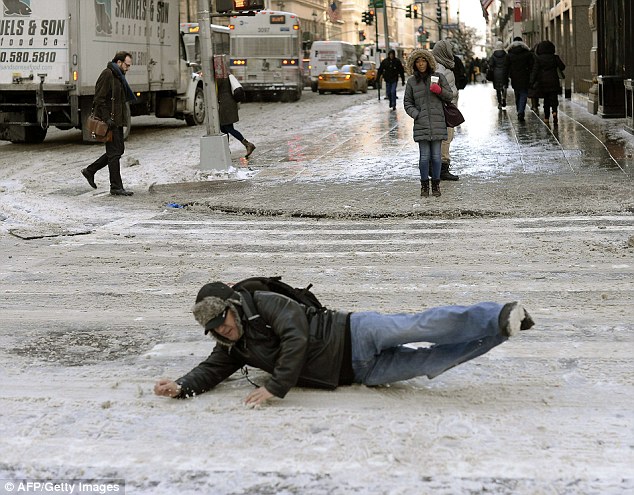You already know falling on ice can literally have a huge impact on the way your body feels and moves. But simply walking on ice can do the same. While you may avoid the breakage and bruising that comes with a fall, walking on ice can change your gait and leave you with aches and pains.

How and Why Gait Patterns Change
The human’s method of walking is unsteady to begin with, thanks to our small base of support, our high center of mass and extended periods where our entire balance relies on a single support unit.¹,² Add an icy surface into the mix and the chances of falling increase significantly.
Icy Surface
In order to decrease our risk of falls, our bodies rely on two strategies to keep our balance. The first is proactive balance, which is when we adjust our posture before we even step on an icy surface because we’re already aware of the challenges such a surface brings. The second is reactive balance, which involves adjusting our posture as needed to retain our balance as we tread across a slippery surface.¹ ²
Proactive Balance
When we see an icy surface we know it’s going to be slippery, our proactive balance strategy automatically kicks in. We typically incorporate muscles we don’t normally use while walking. This, in turn, changes the torque of our joints.¹ ² Both our muscles and joints are performing in ways that are unnatural for our normal gait, affecting muscles and joints in our lower extremities.
This helps explain why you may have aches in pains in your thighs, shins and buttocks areas.² The restricted motion of you lower joints helps explain why your knee and hip joints may feel sore, as you use them more than your ankle joint to help control your balance on slippery surfaces.³
Reactive Balance
Most slips occur when your heel initially hits the ground, which is a crucial event that requires adequate dynamic friction to stop you from slipping.⁴ Dynamic friction refers to the friction between the non-moving ground surface and your heel, which is in motion. When that event lacks the necessary friction, a slip is eminent and a fall possible.⁴
Our reactive balance kicks in to prevent a slip from turning into a fall, and we can suffer from injuries even if we don’t succumb to the fall. Injuries can come from hitting an object other than the ground or from a muscle strain.⁵⁻⁸ Our leg and thigh muscles again take the brunt when our reactive balance comes to the rescue.² ⁹
Obtrusive Footwear
While your body’s biomechanics are already thrown off by walking on a slippery surface, your movements can become even more unnatural and awkward when you add obtrusive footwear to the equation. Bulky boots with thick soles, heavy materials and high or stiff shafts reduce your flexibility even further. This again restricts your normal gait, sometimes calling on lesser-used muscles as you walk.
Why and What Now?
You may be noticing more aches and pains this year over past years due to the unrelenting winter weather. Snow, ice, freezing temperatures and slippery surfaces has been the ongoing norm in several regions. Our gaits have been changed, and our muscles and joints are suffering without a break. Knowing why you’re experiencing such aches and pains may not help reduce your physical discomfort, but it may at least be able to ease your mind.
REFERENCES
-
Gao C, Oksa J, Rintamaki H, Holmer I. Gait Muscle Activity during Walking on an Inclined Icy Surface. Industrial Health. 2008;46:15–22.
-
Winter DA, Ruder GK, MacKinnon CD. Control of balance of upper body during gait. In: Winters JM, Woo S-LY, eds. Multiple muscle systems: biomechanical and movement organization. Springer, Heidelborg; 1990: 534-541.
-
Cham R, Redfern M. Changes in gait when anticipating slippery floors. Gait Posture. 2002;15: 159-171.
-
Redfern M, Idanda B. Slip resistance of the shoe-floor interface under biomechanically relevant conditions. Ergonomics. 1994;37(3):511-524.
-
Hanson JP, Redfern MS, Mazumdar M. Predicting slips and falls considering required and available friction. Ergonomics. 1999;42(12):1619-1633.
-
Manning DP, Shannon HS. Slipping accidents causing low-back pain in a gearbox factory. Spine.1981;6:70-72.
-
Troup DG, Martin JW, Lloyd DC. Back pain in industry, a prospective survey. Spine. 1981:6:61-69.
-
Anderson R, Langerhof E. Accident data in the new Swedish information system on occupational injuries. Ergonomics. 1983;26:33-42.
-
Tang PF, Woollacott MH, Chong RKY. Control of reactive balance adjustments in perturbed human walking: roles of proximal and distal posture muscle activity. Exp Brain Res.1998;119:141-52.
